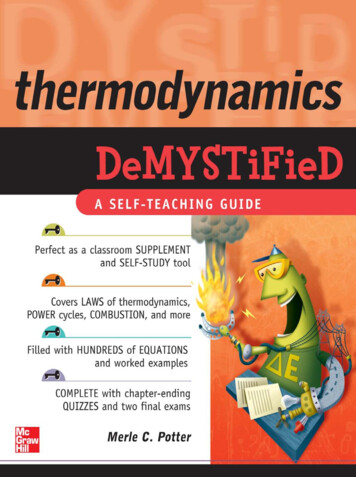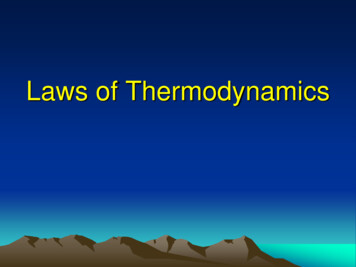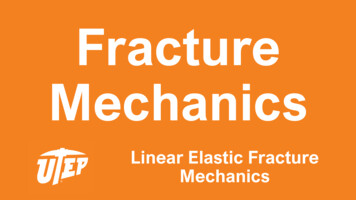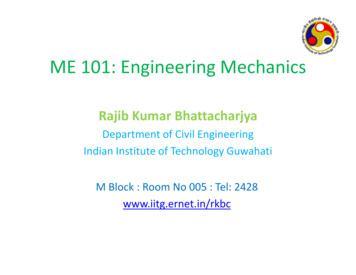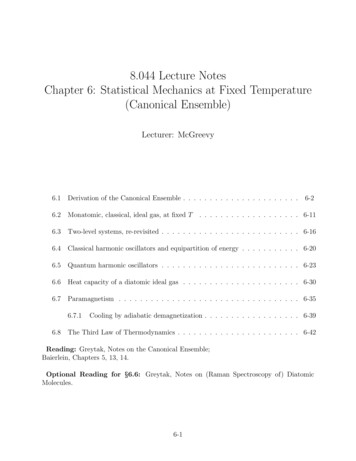
Transcription
Thermodynamics and Statistical MechanicsRichard FitzpatrickProfessor of PhysicsThe University of Texas at AustinContents1 Introduction1.1Intended Audience . . . . . . . . . . . . .1.2Major Sources . . . . . . . . . . . . . . .1.3Why Study Thermodynamics? . . . . . .1.4Atomic Theory of Matter . . . . . . . . .1.5What is Thermodynamics? . . . . . . . .1.6Need for Statistical Approach . . . . . . .1.7Microscopic and Macroscopic Systems . .1.8Classical and Statistical Thermodynamics1.9Classical and Quantum Approaches . . . .2 Probability Theory2.1Introduction . . . . . . . . . . . . . . . . . . .2.2What is Probability? . . . . . . . . . . . . . . .2.3Combining Probabilities . . . . . . . . . . . . .2.4Two-State System . . . . . . . . . . . . . . . .2.5Combinatorial Analysis . . . . . . . . . . . . .2.6Binomial Probability Distribution . . . . . . . .2.7Mean, Variance, and Standard Deviation . . . .2.8Application to Binomial Probability Distribution2.9Gaussian Probability Distribution . . . . . . . .2.10 Central Limit Theorem . . . . . . . . . . . . .Exercises . . . . . . . . . . . . . . . . . . . . .7777788101011.1313131315161718192225263 Statistical Mechanics293.1Introduction . . . . . . . . . . . . . . . . . . . . . . . . . . . . . . . . . . . . . 293.2Specification of State of Many-Particle System . . . . . . . . . . . . . . . . . . . 29
2CONTENTS3.33.43.53.63.73.8Principle of Equal A Priori ProbabilitiesH-Theorem . . . . . . . . . . . . . . .Relaxation Time . . . . . . . . . . . . .Reversibility and Irreversibility . . . . .Probability Calculations . . . . . . . . .Behavior of Density of States . . . . . .Exercises . . . . . . . . . . . . . . . . .4 Heat and Work4.1Brief History of Heat and Work . . . . . . .4.2Macrostates and Microstates . . . . . . . .4.3Microscopic Interpretation of Heat and Work4.4Quasi-Static Processes . . . . . . . . . . . .4.5Exact and Inexact Differentials . . . . . . .Exercises . . . . . . . . . . . . . . . . . . .31323636373839.434345454648515 Statistical Thermodynamics5.1Introduction . . . . . . . . . . . . . . . . . . .5.2Thermal Interaction Between Macrosystems . .5.3Temperature . . . . . . . . . . . . . . . . . . .5.4Mechanical Interaction Between Macrosystems5.5General Interaction Between Macrosystems . .5.6Entropy . . . . . . . . . . . . . . . . . . . . .5.7Properties of Entropy . . . . . . . . . . . . . .5.8Uses of Entropy . . . . . . . . . . . . . . . . .5.9Entropy and Quantum Mechanics . . . . . . . .5.10 Laws of Thermodynamics . . . . . . . . . . . .Exercises . . . . . . . . . . . . . . . . . . . . .5353535659606267687073736 Classical Thermodynamics6.1Introduction . . . . . . . . . . . . . . .6.2Ideal Gas Equation of State . . . . . . .6.3Specific Heat . . . . . . . . . . . . . . .6.4Calculation of Specific Heats . . . . . .6.5Isothermal and Adiabatic Expansion . .6.6Hydrostatic Equilibrium of Atmosphere6.7Isothermal Atmosphere . . . . . . . . .6.8Adiabatic Atmosphere . . . . . . . . . .6.9Internal Energy . . . . . . . . . . . . .6.10 Enthalpy . . . . . . . . . . . . . . . . .6.11 Helmholtz Free Energy . . . . . . . . .6.12 Gibbs Free Energy . . . . . . . . . . . .6.13 General Relation Between Specific Heats.7777788183848586889192939495.
CONTENTS6.146.156.166.176.18Free Expansion of Gas . . .Van der Waals Gas . . . . .Joule-Thompson ThrottlingHeat Engines . . . . . . . .Refrigerators . . . . . . . .Exercises . . . . . . . . . .3.7 Applications of Statistical Thermodynamics7.1Introduction . . . . . . . . . . . . . .7.2Canonical Probability Distribution . .7.3Spin-1/2 Paramagnetism . . . . . . . .7.4System with Specified Mean Energy .7.5Calculation of Mean Values . . . . . .7.6Partition Function . . . . . . . . . . .7.7Ideal Monatomic Gas . . . . . . . . .7.8Gibb’s Paradox . . . . . . . . . . . . .7.9General Paramagnetism . . . . . . . .7.10 Equipartition Theorem . . . . . . . . .7.11 Harmonic Oscillators . . . . . . . . .7.12 Specific Heats . . . . . . . . . . . . .7.13 Specific Heats of Gases . . . . . . . .7.14 Specific Heats of Solids . . . . . . . .7.15 Maxwell Velocity Distribution . . . .7.16 Effusion . . . . . . . . . . . . . . . .7.17 Ferromagnetism . . . . . . . . . . . .Exercises . . . . . . . . . . . . . . . 61381401421461531591621678 Quantum Statistics8.1Introduction . . . . . . . . . . . . . . . . . . .8.2Symmetry Requirements in Quantum Mechanics8.3Illustrative Example . . . . . . . . . . . . . . .8.4Formulation of Statistical Problem . . . . . . .8.5Fermi-Dirac Statistics . . . . . . . . . . . . . .8.6Photon Statistics . . . . . . . . . . . . . . . . .8.7Bose-Einstein Statistics . . . . . . . . . . . . .8.8Maxwell-Boltzmann Statistics . . . . . . . . . .8.9Quantum Statistics in Classical Limit . . . . . .8.10 Quantum-Mechanical Treatment of Ideal Gas . .8.11 Derivation of van der Waals Equation of State .8.12 Planck Radiation Law . . . . . . . . . . . . . .8.13 Black-Body Radiation . . . . . . . . . . . . . .8.14 Stefan-Boltzmann Law . . . . . . . . . . . . .8.15 Conduction Electrons in Metal . . . . . . . . .177177177179181182183184185186189191193196198199.
4CONTENTS8.168.178.188.198.20Sommerfeld Expansion . .White-Dwarf Stars . . . . .Chandrasekhar Limit . . .Neutron Stars . . . . . . .Bose-Einstein CondensationExercises . . . . . . . . . .2032082102112122189 Multi-Phase Systems9.1Introduction . . . . . . . . . . . . . . . . . . . . . . . . . . . .9.2Equilibrium of Isolated System . . . . . . . . . . . . . . . . . .9.3Equilibrium of Constant-Temperature System . . . . . . . . . .9.4Equilibrium of Constant-Temperature Constant-Pressure System9.5Stability of Single-Phase Substance . . . . . . . . . . . . . . . .9.6Equilibrium Between Phases . . . . . . . . . . . . . . . . . . .9.7Clausius-Clapeyron Equation . . . . . . . . . . . . . . . . . . .9.8Phase Diagrams . . . . . . . . . . . . . . . . . . . . . . . . . .9.9Vapor Pressure . . . . . . . . . . . . . . . . . . . . . . . . . . .9.10 Phase Transformations in Van der Waals Fluid . . . . . . . . . .Exercises . . . . . . . . . . . . . . . . . . . . . . . . . . . . . .227227227228230232236237238239240244A Physical ConstantsB Classical MechanicsB.1 Generalized Coordinates .B.2 Generalized Forces . . .B.3 Lagrange’s Equation . . .B.4 Generalized Momenta . .B.5 Calculus of Variations . .B.6 Conditional Variation . .B.7 Multi-Function VariationB.8 Hamilton’s Principle . . .B.9 Hamilton’s Equations . .251.C Wave MechanicsC.1 Introduction . . . . . . . . . . . . . . . . . . .C.2 Photoelectric Effect . . . . . . . . . . . . . . .C.3 Electron Diffraction . . . . . . . . . . . . . . .C.4 Representation of Waves via Complex NumbersC.5 Schrödinger’s Equation . . . . . . . . . . . . .C.6 Probability Interpretation of Wavefunction . . .C.7 Wave Packets . . . . . . . . . . . . . . . . . .C.8 Heisenberg’s Uncertainty Principle . . . . . . .C.9 Stationary States . . . . . . . . . . . . . . . . 270272275276
CONTENTS5C.10 Three-Dimensional Wave Mechanics . . . . . . . . . . . . . . . . . . . . . . . . 278C.11 Simple Harmonic Oscillator . . . . . . . . . . . . . . . . . . . . . . . . . . . . . 281C.12 Angular Momentum . . . . . . . . . . . . . . . . . . . . . . . . . . . . . . . . . 283
6CONTENTS
Introduction71 Introduction1.1 Intended AudienceThese lecture notes outline a single-semester course intended for upper-division physics majors.1.2 Major SourcesThe textbooks that I have consulted most frequently while developing course material are:Fundamentals of Statistical and Thermal Physics: F. Reif (McGraw-Hill, New York NY, 1965).Introduction to Quantum Theory: D. Park, 3rd Edition (McGraw-Hill, New York NY, 1992).Classical and Statistical Thermodynamics: A.S. Carter (Prentice-Hall, Upper Saddle River NJ,2001).1.3 Why Study Thermodynamics?In a nutshell, thermodynamics is the study of the internal motions of many-body systems. Virtually all physical entities that we encounter in everyday life are many-body systems of some type orother (e.g., solids, liquids, gases, and even electromagnetic radiation). Not surprisingly, therefore,thermodynamics is a discipline with an exceptionally wide range of applicability. Indeed, thermodynamics is one of the most extensively used subfields of physics outside physics departments.Prospective engineers, chemists, and material scientists generally do not study relativity or particlephysics, but thermodynamics is an integral, and very important, part of their degree courses.Many people are drawn to physics because they wish to understand why the world around us islike it is. For instance, why the sky is blue, why raindrops are spherical, why we do not fall throughthe floor, et cetera. It turns out that thermodynamics is a very powerful tool for accounting for theobserved features of the physical world. For example, in this course, we shall explain why heatspontaneously flows from hot to cold bodies; why it is impossible to measure a temperature below-273 centigrade; why there is a maximum theoretical efficiency of a power generation unit that cannever be exceeded, no matter what the design; why the Earth’s atmosphere becomes thinner andcolder at higher altitudes; why the Sun appears yellow, whereas colder stars appear red, and hotterstars appear bluish-white; and why high mass stars must ultimately collapse to form black-holes.1.4 Atomic Theory of MatterAccording to the well-known atomic theory of matter, the familiar objects that make up the worldaround us, such as tables and chairs, are themselves made up of a great many microscopic particles.
81.5. What is Thermodynamics?Atomic theory was invented by the ancient Greek philosophers Leucippus and Democritus,who speculated that the world essentially consists of myriads of tiny indivisible particles, whichthey called atoms, from the Greek atomon, meaning “uncuttable.” They speculated, further, that theobserved properties of everyday materials can be explained either in terms of the different shapesof their constituent atoms, or the different motions of these atoms. In some respects, modern atomictheory differs substantially from the primitive theory of Leucippus and Democritus. However, thecentral ideas have remained essentially unchanged. In particular, Leucippus and Democritus werecorrect to suppose that the properties of materials depend not only on the nature of their constituentatoms or molecules, but also on the relative motions of these particles.1.5 What is Thermodynamics?In this course, we shall focus almost exclusively on those physical properties of everyday materialsthat are associated with the motions of their constituent atoms or molecules. In particular, we shallbe concerned with the type of motion that we normally call “heat.” We shall try to establish whatcontrols the flow of heat from one body to another when they are brought into thermal contact. Weshall also attempt to understand the relationship between heat and mechanical work. For instance,to what extent does the heat content of a body increase when mechanical work is done on it? Moreimportantly, can we extract heat from a given body in order to do useful work on some other body?This subject area is called “thermodynamics,” from the Greek roots thermon, meaning “heat,” anddunamis, meaning “power.”1.6 Need for Statistical ApproachIt is necessary to emphasize, from the very outset, that thermodynamics is a difficult subject. Infact, this subject is so difficult that we are forced to adopt a radically different approach to thatemployed in other areas of physics.In most areas of physics, we can formulate some exact, or nearly exact, set of equationsthat governed the system under investigation. For instance, Newton’s equations of motion, orMaxwell’s equations for electromagnetic fields. We can then analyze the system by solving theseequations, either exactly or approximately.In thermodynamics, we have no problem formulating the governing equations. The motions ofatoms and molecules are described exactly by the laws of quantum mechanics. In many cases, theyare also described, to a reasonable approximation, by the much simpler laws of classical mechanics. We shall not be dealing with systems sufficiently energetic for atomic nuclei to be disrupted, sowe need not consider nuclear forces. Also, in general, the gravitational forces between atoms andmolecules are completely negligible. This implies that the forces between atoms and molecules arepredominantly electromagnetic in origin, and are, therefore, very well understood. Thus, we canformulate the exact laws of motion for a thermodynamical system, including all of the inter-atomicforces. The problem is the sheer complexity of the resulting system of equations. In one mole of asubstance (e.g., in twelve grams of carbon, or eighteen grams of water) there are Avagadro’s number of atoms or molecules. That is, about NA 6 10 23 particles. To solve the system exactly, we
Introduction9would have to write down approximately 10 24 coupled equations of motion, with the same numberof initial conditions, and then try to integrate the system. This is plainly impossible. It would alsobe complete overkill. We are generally not interested in knowing the position and velocity of everyparticle in the system as a function of time. Instead, we want to know things like the volume ofthe system, the temperature, the pressure, the heat capacity, the coefficient of expansion, et cetera.We would certainly be hard put to specify more than about fifty, say, interesting properties of athermodynamic system. In other words, the number of pieces of information that we require tocharacterize the state of the system is absolutely minuscule compared to the number of degrees offreedom of the system. That is, the number of pieces of information needed to completely specifyits internal motion. Moreover, the quantities that we are interested in calculating do not depend onthe motions of individual particles, or some some small subset of particles, but, instead, depend onthe average motions of all the particles in the system. In other words, these quantities depend onthe statistical properties of the atomic or molecular motion.The method adopted in thermodynamics is essentially dictated by the enormous complexityof thermodynamic systems. We generally start off with some statistical information about themotions of the constituent atoms or molecules, such as their average kinetic energy, but possessvery little information about the motions of individual particles. We then try to deduce some otherproperties of the system from a statistical treatment of the governing equations of motion. In fact,our approach has to be statistical in nature, because we lack most of the information required tospecify the internal state of the system. The best we can do is to provide a few overall constraints,such as the average volume and the average energy.Thermodynamic systems are ideally suited to a statistical approach, because of the enormousnumbers of particles that they contain. Statistical arguments actually get more exact as the numbersinvolved get larger. For example, consider an opinion poll published in a newspaper. Such a pollusually specifies how many people were interviewed. This number is significant because, evenif the polling was done without bias, which is extremely unlikely, the laws of statistics say thatthere is a intrinsic error (in the fraction of people who supposedly support a given opinion) oforder one over the square root of the number of people questioned. It follows that if a thousandpeople were interviewed, which is a typical number, then the error is at least three percent. Wecan easily appreciate that if we do statistics on a thermodynamic system containing 10 24 particlesthen we are going to obtain results that are valid to incredible accuracy. In fact, in most situations,we can forget that the results are statistical at all, and treat them as exact laws of physics. Forinstance, the familiar equation of state of an ideal gas, P V ν R T (see Section 6.2), is actuallya statistical result. In other words, it relates the average pressure, and the average volume, to theaverage temperature. However, for one mole of gas, the relative statistical deviations from averagevalues are only about 10 12 , according to the 1/NA1/2 law. Of course, it is virtually impossible tomeasure the pressure, volume, or temperature of a gas to such accuracy, so it is often convenientto forget about the fact that the ideal gas law is a statistical result, and treat it as a law of physicsinterrelating the actual pressure, volume, and temperature of an ideal gas.
101.7. Microscopic and Macroscopic Systems1.7 Microscopic and Macroscopic SystemsIt is useful, at this stage, to make a distinction between the different sizes of the systems that weare going to examine. We shall call a system microscopic if it is roughly of atomic dimensions, orsmaller. On the other hand, we shall call a system macroscopic if it is large enough to be visible inthe ordinary sense. This is a rather inexact definition. The exact definition depends on the numberof particles in the system, which we shall call N. A system is macroscopic if 1/N 1/2 1, whichmeans that statistical arguments can be applied to reasonable accuracy. For instance, if we wishto keep the relative statistical error below one percent then a macroscopic system would have tocontain more than about ten thousand particles. Any system containing less than this number ofparticles would be regarded as essentially microscopic, and, hence, statistical arguments could notbe applied to such a system without unacceptable error.1.8 Classical and Statistical ThermodynamicsIn this course, we are going to develop some machinery for interrelating the statistical propertiesof a system containing a very large number of particles, via a statistical treatment of the laws ofatomic or molecular motion. It turns out that, once we have developed this machinery, we canobtain some very general results that do not depend on the exact details of the statistical treatment.These results can be described without reference to the underlying statistical nature of the system,but their validity depends ultimately on statistical arguments. They take the form of general statements regarding heat and work, and are usually referred to as classical thermodynamics, or justthermodynamics, for short. Historically, classical thermodynamics was the first type of thermodynamics to be discovered. In fact, for many years, the laws of classical thermodynamics seemedrather mysterious, because their statistical justification had yet to be discovered. The strength ofclassical thermodynamics is its great generality, which comes about because it does not depend onany detailed assumptions about the statistical properties of the system under investigation. Thisgenerality is also the principle weakness of classical thermodynamics. Only a relatively few statements can be made on such general grounds, so many interesting properties of the system remainoutside the scope of classical thermodynamics.If we go beyond classical thermodynamics, and start to investigate the statistical machinerythat underpins it, then we get all of the results of classical thermodynamics, plus a large numberof other results that enable the macroscopic parameters of the system to be calculated from aknowledge of its microscopic constituents. This approach is known as statistical thermodynamics,and is extremely powerful. The only drawback is that the further we delve inside the statisticalmachinery of thermodynamics, the harder it becomes to perform the necessary calculations.Note that both classical and statistical thermodynamics are only valid for systems in equilibrium. If the system is not in equilibrium then the problem becomes considerably more difficult.In fact, the thermodynamics of non-equilibrium systems, which is generally called irreversiblethermodynamics, is a graduate-level subject.
Introduction111.9 Classical and Quantum ApproachesWe mentioned earlier that the motions (by which we really meant the translational motions) ofatoms and molecules are described exactly by quantum mechanics, and only approximately byclassical mechanics. It turns out that the non-translational motions of molecules, such as theirrotation and vibration, are very poorly described by classical mechanics. So, why bother usingclassical mechanics at all? Unfortunately, quantum mechanics deals with the translational motions of atoms and molecules (via wave mechanics) in a rather awkward manner. The classicalapproach is far more straightforward, and, under most circumstances, yields the same statisticalresults. Hence, throughout the first part of this course, we shall use classical mechanics, as muchas possible, to describe the translational motion of atoms and molecules, and will reserve quantummechanics for dealing with non-translational motions. However, towards the end of this course, inChapter 8, we shall switch to a purely quantum-mechanical approach.
121.9. Classical and Quantum Approaches
Probability Theory132 Probability Theory2.1 IntroductionThis chapter is devoted to a brief, and fairly low-level, introduction to a branch of mathematicsknown as probability theory. In fact, we do not need to know very much about probability theory in order to understand statistical thermodynamics, because the probabilistic calculation thatultimately underpins the latter subject area is extraordinarily simple.2.2 What is Probability?What is the scientific definition of probability? Consider an observation made on a general system,S . This can result in any one of a number of different possible outcomes. We want to find theprobability of some general outcome, X. In order to ascribe a probability, we have to considerthe system as a member of a large set, Σ, of similar systems. Mathematicians call such a groupan ensemble, which is just the French for “group.” So, let us consider an ensemble, Σ, of similarsystems, S . The probability of the outcome X is defined as the ratio of the number of systems inthe ensemble that exhibit this outcome to the total number of systems, in the limit where the latternumber tends to infinity. We can write this symbolically asP(X) lt Ω(Σ) Ω(X),Ω(Σ)(2.1)where Ω(Σ) is the total number of systems in the ensemble, and Ω(X) the number of systemsexhibiting the outcome X. We can see that the probability, P(X), must be a number lying between0 and 1. The probability is zero if no systems exhibit the outcome X, even when the number ofsystems goes to infinity. This is just another way of saying that the outcome X is impossible. Theprobability is unity if all systems exhibit the outcome X, in the limit that the number of systemsgoes to infinity. This is another way of saying that the outcome X is bound to occur.2.3 Combining ProbabilitiesConsider two distinct possible outcomes, X and Y, of an observation made on the system S , withprobabilities of occurrence P(X) and P(Y), respectively. Let us determine the probability of obtaining either the outcome X or the outcome Y, which we shall denote P(X Y). From the basicdefinition of probability,Ω(X Y)P(X Y) lt Ω(Σ) ,(2.2)Ω(Σ)where Ω(X Y) is the number of systems in the ensemble that exhibit either the outcome X or theoutcome Y. It is clear thatΩ(X Y) Ω(X) Ω(Y)(2.3)
142.3. Combining Probabilitiesif the outcomes X and Y are mutually exclusive (which must be the case if they are two distinctoutcomes). Thus,P(X Y) P(X) P(Y).(2.4)We conclude that the probability of obtaining either the outcome X or the outcome Y is the sumof the individual probabilities of X and Y. For instance, with a six-sided die, the probabilityof throwing any particular number (one to six) is 1/6, because all of the possible outcomes areconsidered to be equally likely. It follows, from the previous discussion, that the probability ofthrowing either a one or a two is 1/6 1/6, which equals 1/3.Let us denote all of the M, say, possible outcomes of an observation made on the system S byXi , where i runs from 1 to M. Let us determine the probability of obtaining any of these outcomes.This quantity is clearly unity, from the basic definition of probability, because every one of thesystems in the ensemble must exhibit one of the possible outcomes. However, this quantity isalso equal to the sum of the probabilities of all the individual outcomes, by Equation (2.4), so weconclude that this sum is equal to unity. Thus, P(Xi ) 1,(2.5)i 1,Mwhich is called the normalization condition, and must be satisfied by any complete set of probabilities. This condition is equivalent to the self-evident statement that an observation of a systemmust definitely result in one of its possible outcomes.There is another way in which we can combine probabilities. Suppose that we make an observation on a state picked at random from the ensemble, and then pick a second state, completelyindependently, and make another observation. Here, we are assuming that the first observationdoes not influence the second observation in any way. In other words, the two observations arestatistically independent. Let us determine the probability of obtaining the outcome X in the firststate and the outcome Y in the second state, which we shall denote P(X Y). In order to determinethis probability, we have to form an ensemble of all of the possible pairs of states that we couldchoose from the ensemble, Σ. Let us denote this ensemble Σ Σ. It is obvious that the numberof pairs of states in this new ensemble is just the square of the number of states in the originalensemble, soΩ(Σ Σ) Ω(Σ) Ω(Σ).(2.6)It is also fairly obvious that the number of pairs of states in the ensemble Σ Σ that exhibit theoutcome X in the first state, and Y in the second state, is just the product of the number of statesthat exhibit the outcome X, and the number of states that exhibit the outcome Y, in the originalensemble. Hence,Ω(X Y) Ω(X) Ω(Y).(2.7)It follows from the basic definition of probability thatΩ(X Y)P(X Y) lt Ω(Σ) P(X) P(Y).(2.8)Ω(Σ Σ)Thus, the probability of obtaining the outcomes X and Y in two statistically independent observations is the product of the individual probabilities of X and Y. For instance, the probability ofthrowing a one and then a two on a six-sided die is 1/6 1/6, which equals 1/36.
Probability Theory152.4 Two-State SystemThe simplest non-trivial system that we can investigate using probability theory is one for whichthere are only two possible outcomes. (There would obviously be little point in investigating aone-outcome system.) Let us suppose that there are two possible outcomes to an observation madeon some system, S . Let us denote these outcomes 1 and 2, and let their probabilities of occurrencebeP(1) p,(2.9)P(2) q.(2.10)It follows immediately from the normalization condition, Equation (2.5), thatp q 1,(2.11)so q 1 p. The best known example of a two-state system is a tossed coin. The two outcomesare “heads” and “tails,” each with equal probabilities 1/2. So, p q 1/2 for this system.Suppose that we make N statistically ind
stars appear bluish-white; and why high mass stars must ultimately collapse to form black-holes. . In other words, the number of pieces of information that we require to characterize the state of the system is absolutely minuscule compared to the number of degrees of freedom of the system. That is, the

